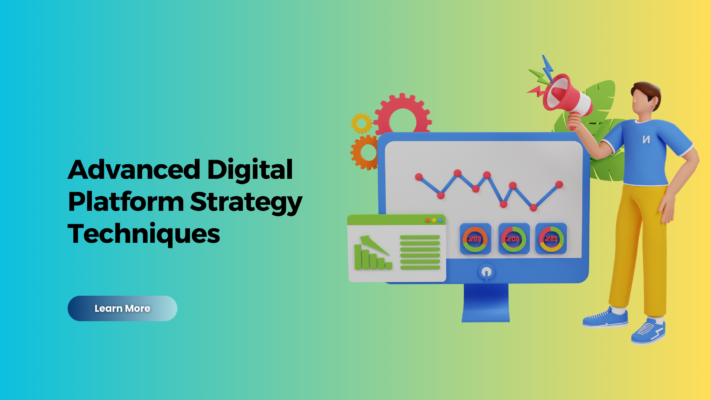
In today’s digital landscape, businesses of all sizes are recognizing the critical importance of having a robust and well-defined digital platform strategy. As technology continues to evolve at a breakneck pace, the companies that can effectively leverage digital platforms to engage with their customers, streamline operations, and drive innovation will be the ones that thrive in an increasingly competitive marketplace.
But what exactly is a digital platform strategy, and why is it so crucial for modern businesses? More importantly, how can companies move beyond the basics and implement advanced techniques to truly maximize the potential of their digital platforms? In this comprehensive guide, we’ll explore these questions in depth, providing insights and actionable steps to help you take your digital platform strategy to the next level.
What is a Digital Platform Strategy?
At its core, a digital platform strategy is a comprehensive plan that outlines how a company will leverage digital technologies, platforms, and ecosystems to create value for its customers, partners, and stakeholders. It encompasses a wide range of elements, including:
1. Digital Products and Services: The digital offerings a company provides, such as mobile apps, web applications, e-commerce platforms, and digital content.
2. Digital Channels: The various digital touchpoints and channels through which a company interacts with its customers, including social media, email, messaging apps, and online communities.
3. Digital Infrastructure: The underlying technologies, systems, and architectures that support a company’s digital operations, such as cloud computing, APIs, and data platforms.
4. Digital Processes: The digital workflows, automation, and integration that enable efficient and seamless operations across the organization.
5. Digital Ecosystems: The network of partners, developers, and complementary services that extend the reach and capabilities of a company’s digital offerings.
A well-crafted digital platform strategy serves as a roadmap, guiding a company’s digital transformation efforts and ensuring that all digital initiatives are aligned with its overall business objectives and customer needs.
Why is a Digital Platform Strategy Important?
In today’s fast-paced and highly competitive business environment, a robust digital platform strategy is no longer a luxury – it’s a necessity. Here are some compelling reasons why every modern business should prioritize developing and implementing a comprehensive digital platform strategy:
1. Customer Expectations: Customers today expect seamless, personalized, and convenient digital experiences across all touchpoints. A strong digital platform strategy enables companies to meet and exceed these expectations, enhancing customer satisfaction and loyalty.
2. Operational Efficiency: By leveraging digital technologies and automating processes, companies can streamline their operations, reduce costs, and increase productivity, leading to improved profitability and competitiveness.
3. Data-Driven Insights: Digital platforms generate vast amounts of data, which can be analyzed to gain valuable insights into customer behavior, market trends, and operational performance. These insights can inform strategic decision-making and drive innovation.
4. Innovation and Agility: A well-designed digital platform strategy fosters a culture of innovation and agility, enabling companies to rapidly adapt to changing market conditions, experiment with new ideas, and quickly bring new products and services to market.
5. Ecosystem Enablement: By embracing digital ecosystems and partnerships, companies can extend their reach, tap into new revenue streams, and access complementary capabilities, fostering growth and competitive advantage.
Benefits of an Advanced Digital Platform Strategy
While implementing a basic digital platform strategy can provide tangible benefits, taking it to the next level with advanced techniques can unlock even greater opportunities for businesses. Here are some of the key advantages of adopting an advanced digital platform strategy:
1. Enhanced Customer Experiences: Advanced digital platform strategies enable companies to deliver highly personalized, contextualized, and seamless experiences across all touchpoints, fostering deeper customer engagement and loyalty.
2. Accelerated Innovation: By leveraging cutting-edge technologies, such as artificial intelligence (AI), machine learning (ML), and the Internet of Things (IoT), companies can accelerate their innovation cycles, rapidly develop and test new products and services, and respond quickly to market shifts.
3. Increased Operational Efficiency: Advanced automation, process optimization, and real-time data analytics can significantly enhance operational efficiency, reducing costs and improving productivity across the entire organization.
4. Competitive Differentiation: By embracing advanced digital platform strategies, companies can differentiate themselves from competitors, offering unique and compelling digital experiences that create enduring competitive advantages.
5. Ecosystem Expansion: Advanced digital platforms enable companies to seamlessly integrate with a broader range of partners, developers, and complementary services, expanding their ecosystem and unlocking new revenue streams and growth opportunities.
Advanced Digital Platform Strategy Techniques
To reap the full benefits of a digital platform strategy, companies must go beyond the basics and embrace advanced techniques that leverage emerging technologies and innovative approaches. Here are some cutting-edge techniques that forward-thinking businesses are adopting:
1. Microservices and API-Driven Architecture
Traditional monolithic applications are increasingly being replaced by modern, API-driven architectures built on microservices. This approach enables faster development cycles, easier scalability, and greater flexibility in integrating with other systems and services. By embracing microservices and API-driven architectures, companies can accelerate the delivery of new features and functionalities, enhance agility, and foster innovation.
2. Artificial Intelligence and Machine Learning
AI and ML are rapidly transforming the digital landscape, enabling companies to deliver highly personalized and intelligent experiences, automate complex processes, and uncover valuable insights from vast amounts of data. From chatbots and virtual assistants to predictive analytics and recommendation engines, the applications of AI and ML in digital platforms are virtually limitless.
3. Internet of Things (IoT) Integration
The proliferation of connected devices and sensors presents a wealth of opportunities for businesses to create new digital experiences and services. By integrating IoT technologies into their digital platforms, companies can collect and analyze real-time data from various sources, enabling proactive decision-making, predictive maintenance, and the development of innovative, connected products and services.
4. Headless and Decoupled Architectures
Headless and decoupled architectures separate the front-end user experience from the back-end systems and data, allowing for greater flexibility and adaptability in delivering content and functionality across multiple channels and devices. This approach enables companies to create omnichannel experiences, future-proof their digital platforms, and rapidly adapt to emerging technologies and consumer trends.
5. Serverless Computing and Cloud-Native Applications
Serverless computing and cloud-native applications offer scalability, cost-efficiency, and rapid deployment benefits, making them ideal for building and running modern digital platforms. By embracing these technologies, companies can focus on developing and delivering value-added services without the overhead of managing and maintaining underlying infrastructure.
6. Ecosystem Integration and Partnerships
As digital ecosystems continue to expand, integration with third-party services, platforms, and complementary offerings becomes increasingly important. By fostering strategic partnerships and seamlessly integrating with external ecosystems, companies can extend their reach, access new capabilities, and create more comprehensive and compelling digital experiences for their customers.
7. Continuous Delivery and DevOps
To keep pace with rapidly evolving customer needs and market conditions, companies must adopt agile development methodologies, continuous delivery practices, and DevOps principles. By automating the software delivery pipeline and fostering collaboration between development and operations teams, businesses can accelerate the deployment of new features and updates, ensuring their digital platforms remain relevant and competitive.
8. Data-Driven Decision-Making and Analytics
Advanced data analytics and business intelligence capabilities are essential for making informed decisions and optimizing digital platform performance. By leveraging techniques such as predictive analytics, real-time data processing, and advanced visualization tools, companies can gain deep insights into customer behavior, operational inefficiencies, and emerging trends, enabling data-driven decision-making and continuous improvement.
9. Cybersecurity and Privacy by Design
As digital platforms become more complex and interconnected, ensuring robust cybersecurity and data privacy measures is paramount. By adopting a “security-by-design” approach and implementing advanced security technologies, such as zero-trust architectures, multi-factor authentication, and encryption, companies can protect their digital assets, safeguard customer data, and maintain trust and confidence in their digital offerings.
10. User Experience (UX) and Design Thinking
Exceptional user experiences are the cornerstone of successful digital platforms. By embracing design thinking principles and incorporating user-centered design methodologies, companies can create intuitive, engaging, and delightful digital experiences that truly resonate with their target audiences. Continuous user research, testing, and iterative improvements are key to staying ahead in the ever-evolving digital landscape.
These advanced techniques are just the tip of the iceberg when it comes to the possibilities and potential of digital platform strategies. As technology continues to evolve, new approaches and methodologies will emerge, providing companies with even more opportunities to innovate and differentiate their digital offerings.
Implementing an Advanced Digital Platform Strategy
While the benefits of adopting advanced digital platform strategies are clear, successfully implementing them can be a complex and challenging endeavor. Here are some key considerations and steps to help ensure a successful implementation:
1. Establish a Clear Vision and Roadmap: Begin by clearly defining the vision, objectives, and desired outcomes for your advanced digital platform strategy. Develop a detailed roadmap that outlines the key initiatives, timelines, and resources required to achieve your goals.
2. Embrace Organizational Change: Implementing an advanced digital platform strategy often requires significant organizational changes, both in terms of processes and culture. Foster a culture of innovation, agility, and continuous learning, and ensure that all stakeholders are aligned and committed to the transformation.
3. Invest in Talent and Skills Development: Building and maintaining advanced digital platforms requires a diverse set of skills, including software development, data analytics, UX design, and more. Invest in attracting and retaining top talent, and provide ongoing training and professional development opportunities to upskill your existing workforce.
4. Leverage Partnerships and Ecosystems: Recognize that you can’t do everything in-house. Identify strategic partners and ecosystem players that can complement your capabilities and provide specialized expertise or services. Foster collaboration and seamless integration to create a robust and comprehensive digital platform.
5. Prioritize Data and Analytics: Advanced digital platforms generate vast amounts of data. Implement robust data management strategies, invest in advanced analytics tools and techniques, and promote a data-driven decision-making culture to extract maximum value from your digital platforms.
6. Embrace Agile and DevOps Practices: Adopt agile methodologies, continuous delivery practices, and DevOps principles to accelerate the development and deployment of new features and updates. Encourage cross-functional collaboration and automation to streamline processes and improve efficiency.
7. Continuously Iterate and Improve: Digital platforms are living entities that require constant refinement and optimization. Continuously gather feedback from users, analyze performance data, and iterate on your digital offerings to ensure they remain relevant, engaging, and competitive.
Conclusion
In today’s rapidly evolving digital landscape, businesses that fail to embrace advanced digital platform strategies risk being left behind. By implementing cutting-edge techniques such as microservices, AI/ML, IoT integration, headless architectures, and data-driven decision-making, companies can unlock new levels of innovation, operational efficiency, and customer engagement.
However, successfully executing an advanced digital platform strategy is no small feat. It requires a clear vision, organizational agility, investment in talent and technology, and a commitment to continuous improvement.
If you’re ready to take your digital platform strategy to the next level, consider partnering with Upcore Technologies. As a leading provider of digital transformation solutions, Upcore Technologies has extensive experience in helping businesses design, implement, and optimize advanced digital platforms. With their expertise in emerging technologies, agile methodologies, and industry best practices, Upcore Technologies can be your trusted partner in navigating the complexities of the digital landscape and achieving lasting success.
Embrace the future of digital platforms, and position your business for long-term growth and competitiveness in an increasingly digital world.


